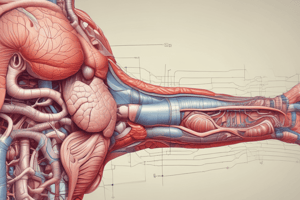Podcast
Questions and Answers
The process turns the chyme into a milky fluid called ______.
The process turns the chyme into a milky fluid called ______.
chyle
The middle section of the small intestine is known as the ______.
The middle section of the small intestine is known as the ______.
jejunum
The last section of the small intestine is called the ______.
The last section of the small intestine is called the ______.
ileum
The large intestine consists of three parts: the caecum, the colon, and the ______.
The large intestine consists of three parts: the caecum, the colon, and the ______.
The accessory glands include the salivary glands, the liver, and the ______.
The accessory glands include the salivary glands, the liver, and the ______.
The liver secretes bile, which is stored in the ______.
The liver secretes bile, which is stored in the ______.
The salivary glands contain ______, which helps break down carbohydrates.
The salivary glands contain ______, which helps break down carbohydrates.
The pancreas secretes pancreatic juices to reduce ______ in the intestine.
The pancreas secretes pancreatic juices to reduce ______ in the intestine.
The digestive tract is a very long tube made up of the mouth, pharynx, esophagus, stomach, small intestine, large intestine and ______.
The digestive tract is a very long tube made up of the mouth, pharynx, esophagus, stomach, small intestine, large intestine and ______.
The mouth contains the ______, a muscular organ that helps with chewing and tasting food.
The mouth contains the ______, a muscular organ that helps with chewing and tasting food.
The salivary glands produce ______, which is mixed with food to aid in digestion.
The salivary glands produce ______, which is mixed with food to aid in digestion.
Food travels from the mouth to the ______, which is a tube belonging to both the digestive and respiratory systems.
Food travels from the mouth to the ______, which is a tube belonging to both the digestive and respiratory systems.
The stomach is connected to the esophagus through an opening called the ______.
The stomach is connected to the esophagus through an opening called the ______.
In the stomach, gastric juices secreted by glands help carry out the digestion of ______.
In the stomach, gastric juices secreted by glands help carry out the digestion of ______.
The first part of the small intestine is called the ______, where digestive juices mix with food.
The first part of the small intestine is called the ______, where digestive juices mix with food.
Nutrients obtained from the digestion process are passed into the bloodstream through ______.
Nutrients obtained from the digestion process are passed into the bloodstream through ______.
Flashcards
Digestive Tract
Digestive Tract
A long tube containing organs that break down food.
Mechanical Digestion
Mechanical Digestion
Breaking down food into smaller pieces by chewing or muscles.
Chemical Digestion
Chemical Digestion
Breaking down food using enzymes.
Bolus
Bolus
Signup and view all the flashcards
Chyme
Chyme
Signup and view all the flashcards
Small Intestine Villi
Small Intestine Villi
Signup and view all the flashcards
Pancreatic Juice
Pancreatic Juice
Signup and view all the flashcards
Intestinal Villi
Intestinal Villi
Signup and view all the flashcards
Chyme converted to chyle
Chyme converted to chyle
Signup and view all the flashcards
Jejunum function
Jejunum function
Signup and view all the flashcards
Ileum function
Ileum function
Signup and view all the flashcards
Large intestine structure
Large intestine structure
Signup and view all the flashcards
Accessory glands location
Accessory glands location
Signup and view all the flashcards
Salivary glands function
Salivary glands function
Signup and view all the flashcards
Liver function
Liver function
Signup and view all the flashcards
Pancreas function
Pancreas function
Signup and view all the flashcards
Study Notes
Digestive System Overview
- The digestive tract is a long tube from mouth to anus.
- It includes mouth, pharynx, esophagus, stomach, small intestine, large intestine, and anus.
Mouth
- Mechanical digestion: Chewing (mastication) by teeth.
- Mechanical digestion: Tongue movement.
- Chemical digestion: Saliva (from salivary glands) breaks down carbohydrates.
- Food is formed into a bolus.
Pharynx
- Passageway for both food and air.
- Epiglottis, a flap, closes the trachea during swallowing, preventing food from entering the lungs.
Esophagus
- Food moves from the pharynx to the stomach via peristalsis (muscle contractions).
Stomach
- Cardia: Opening connecting esophagus to stomach.
- Strong stomach muscles (mechanical digestion) grind food.
- Gastric juices (chemical digestion): kill bacteria, break down proteins.
- Pylorus: Opening connecting stomach to small intestine.
- Chyme: Processed food from stomach.
Small Intestine
- Very long tube with villi (folds) for increased surface area and nutrient absorption.
- Capillaries in villi absorb nutrients into the bloodstream.
- Three parts: duodenum, jejunum, ileum.
- Duodenum: Receives bile (liver) and pancreatic juices (pancreas) to further break down food.
- Jejunum: Middle section, significant nutrient absorption.
- Ileum: Final section, absorbs remaining nutrients and water.
- Chyle: Milky fluid formed in the intestines after digestion.
Large Intestine
- Wider than small intestine.
- Three parts: caecum, colon, rectum.
- Absorbs water from undigested material.
- Rectum: Stores waste.
- Anus: Waste elimination.
Accessory Glands
- Located outside the tract, but contribute digestive juices.
- Salivary glands, liver, pancreas.
Salivary Glands
- Secrete saliva containing amylase (carbohydrate-digesting enzyme).
Liver
- Largest gland in body.
- Secretes bile (stored in gallbladder).
- Bile aids in lipid (fat) digestion (not an enzyme).
- Other functions: glucose, iron, vitamin storage; toxin removal.
Pancreas
- Arrowhead-shaped gland beneath stomach.
- Digestive function: Secretes pancreatic juices (neutralize stomach acid).
- Endocrine function: Releases hormones into bloodstream.
Studying That Suits You
Use AI to generate personalized quizzes and flashcards to suit your learning preferences.




